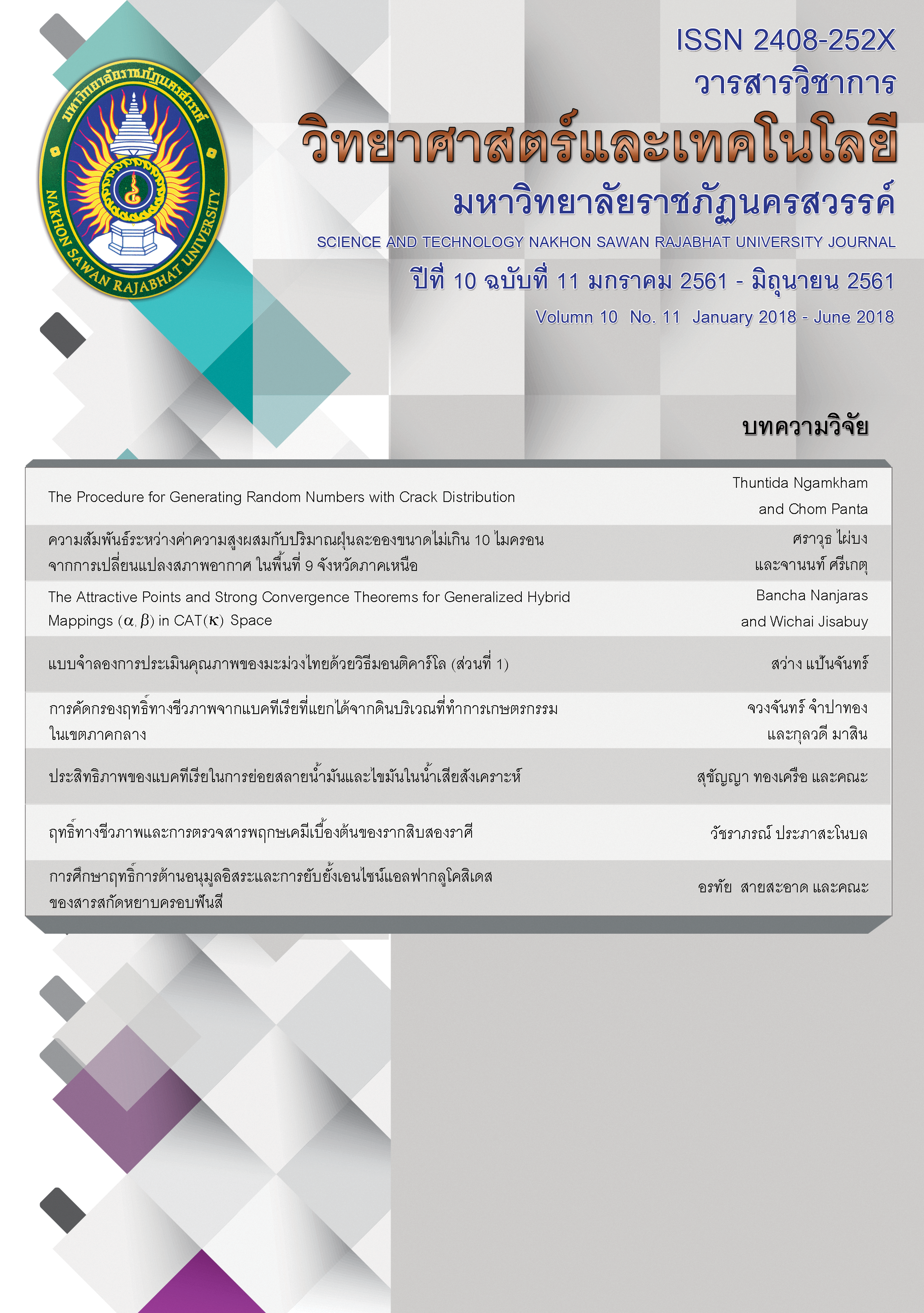ฤทธิ์ทางชีวภาพและการตรวจสารพฤกษเคมีเบื้องต้นของรากสิบสองราศี
Main Article Content
Abstract
Launaea sarmentosa (Willd.) Sch. Bip. ex Kuntze is Thai medicinal plant, which is distributed in Phetchaburi province. This plant was collected from Bangkrok sub-district of Phetchaburi province. There were a few reports data about the biological activities of L. sarmentosa extracts. The aim of this study was to investigate the biological activities of the ethanolic extracts of L. sarmentosa root. The extracts was evaluated for their biological activities including anti-Mycobacterium tuberculosis activity, antivirus-H5N1, anti-HSV-1 (H. simplex type-1), anti-bacterial activity against Bacillus cereus (anti-B. cereus), antifungal activity against Candida albican and cytotoxic activity against three human cancer cell lines including epidermoid carcinoma of oral cavity KB, breast adenocarcinoma MCF-7 and small cell lung cancer NCI-H187 by using Green fluorescent protein microplate assay (GFPMA), UNANA-based enzyme inhibition assay, Green Fluorescent Protein (GFP)–based assay and Resazurin Microplate assay (REMA), respectively. The results showed that the extracts was inactive to all of biological assays except only anti-Mycobacterium tuberculosis activity with the concentration values of 50 µg/ml. In addition, in vitro cytotoxicity of the extracts was non toxicity to Vero cells. Phytochemicals screening of root extracts in ethanol revealed the presence of alkaloid, steroid and flavonoid.
Article Details
References
กระทรวงสาธารณสุข.
กี่ คูหลำ. (2550). ผู้ใช้สิบสองราศี. ตำบลบางครก อำเภอบ้านแหลม จังหวัดเพชรบุรี. สัมภาษณ์ 5
กุมภาพันธ์ 2550.
ตรีบุปผา มิ่งเมือง ดำรงค์ พงศ์พุทธชาติและบุษกร อุ๋ยวงษ์. (2551). ฤทธิ์ต้านเชื้อจุลินทรีย์ของสารสกัด
จากใบสิบสองราศี. ใน การประชุมนำเสนอผลการวิจัยมหาวิทยาลัยราชภัฏเพชรบุรีครั้งที่ 1.
เพชรบุรี: มหาวิทยาลัยราชภัฏเพชรบุรี.
บุษราคัม ทรัพย์อุดมผลและปรีชา ภูวไพรศิริศาล. (2551). องค์ประกอบทางเคมีจากผักลิ้นห่าน.ในการ
ประชุมนำเสนอผลการวิจัยมหาวิทยาลัยราชภัฏเพชรบุรีครั้งที่ 1. เพชรบุรี: มหาวิทยาลัยราช
ภัฏเพชรบุรี.
พิสมัย เหล่าภัทรเกษม. (2548). บทบาทของผลิตภัณฑ์ธรรมชาติในการป้องกันและรักษามะเร็ง.
ศรีนครินทร์เวชสาร, 20(3), 180-189.
รัตนา อินทรานุปกรณ์. (2547). การตรวจสอบและการสกัดแยกสารสำคัญจากสมุนไพร. กรุงเทพฯ:
สำนักพิมพ์แห่งจุฬาลงกรณ์มหาวิทยาลัย.
วัชราภรณ์ ประภาสะโนบล. (2556). ฤทธิ์ต้านออกซิเดชัน ต้านการอักเสบและต้านมะเร็งจากใบสิบสอง
ราศี. ใน การประชุมวิชาการระดับชาติ ราชภัฏสุราษฎร์ธานีวิจัย ครั้งที่ 9. สุราษฎร์ธานี:
มหาวิทยาลัยราชภัฏสุราษฎร์ธานี
. วัชราภรณ์ ประภาสะโนบลและสุนันทา แก้วสระแสน. (2555). ฤทธิ์การต้านอนุมูลอิสระและปริมาณสาร
ฟีนอลิกทั้งหมดของสารสกัดจากใบสิบสองราศี. วารสารวิทยาศาสตร์แห่งมหาวิทยาลัยราชภัฏ
เพชรบุรี, 9 (1), 12-19.
วัชราภรณ์ ประภาสะโนบล สุริยา น้อยสุวรรณ์ วารุณี นาคสงค์และชรินรัตน์ ศรัทธาผล. (2557). ฤทธิ์ทาง
ชีวภาพและการตรวจสารพฤกษเคมีเบื้องต้นจากใบสิบสองราศี. ใน การประชุมวิชาการระดับชาติ
วิทยาศาสตร์ศึกษาเพื่อสร้างแรงบันดาลใจสู่นวัตกรรมครั้งที่ 1. เพชรบุรี: มหาวิทยาลัยราชภัฏ เพชรบุรี.
สินธพ โฉมยา, ชวลิต สิทธิสมบัติ, วันดี ญาณไพศาล, นุชนาฏ กิจเจริญ, อุทัย โสธนะพันธุ์และเพ็ญพรรณ
เวชวิทยาขลัง.(2552).[อินเทอร์เน็ต]. นครปฐม: คณะเภสัชศาสตร์ มหาวิทยาลัยศิลปากร
;[ปรับปรุงเมื่อ 2552; เข้าถึงเมื่อวันที่ 5 ตุลาคม2555].การตรวจสอบเบื้องต้นทางพฤกษเคมี.
เข้าถึงได้จาก:https://pg.pharm.su.ac.th/course/pcoglab1/screen/method/method.htm
Arun, A.B., Beena, K.R., Raviraja, N.S., & Sridhar, K.R. (2010). Coastal sand dunesa neglected
ecosystem. [Internet]. Oct [cited 2015 Aug 14]. Available from:
https://www.ias.ac.in/currsci/jul10/articles9.htm
Beer, D., Joubert, E., Gelderblom, W.C.A., & Manley, M. (2002). Phenolic compounds: A review
of their possible role as in vivo antioxidants of wine. South African Journal of Enology and Viticulture, 23(2), 48-61.
Bousselessela, H., Yahia, M., Mahboubi, A., Benbia, S., & Massinissa, Y. (2013). Antioxidant and
antibacterial activity of alkaloids and terpenes extracts from Euphorbia granulate, International Journal of Biological, Biomolecular, Agricultural, Food and Biotechnological Engineering, 7(3).
Brien, J.O., Wilson, I., Orton, T., & Pognan, F. (2000). Investigation of the alamar blue (resazurin)
fluorescent dye for the assessment of mammalian cell cytotoxicity. European Journal of Biochemistry , 267: 5421-5426.
Changsen, C., Franzblan, S., & Palittapongarnpim, P. (2003). Improved green fluorescent protein reporter gene-based microplate screening for antituberculosis compounds by utilizing an acetamidase promoter. Antimicrob.Agents Chemother; 47, 3682-3687.
Ghasemzadeh, A., Jaafar, H.Z.E.,& Rahmat, A. (2010). Antioxidant activities, total phenolics and
flavonoids content in two varieties of Malaysia young ginger (Zingiber officianle Roscoe). Molecules, 15, 4324-4333.
Harborne, J.B. (1998). Phytochemical Methods. A Guide to Modern Techniques of Plant Analysis. 3rd ed. London: Chapman & Hall ,182-190.
Hunt, L., Jordan, M., De, J.M., & Wurm, F.M. (1999). GFP-expressing mammalian cells for fast,
sensitive, noninvasive cell growth assessment in a kinetic mode. Biotechnol and Bioeng, 65, 201-205.
Hurt, A.C., Okomo-Adhiambo, M., & Gubareva, L.V. (2012). The fluorescence neuraminidase inhibition assay: a functional method for detection of influenza virus resistance to the neuraminidase inhibitors. Methods Mol Biol, 865,115-25.
Ozcelik, B., Orhan, D.D., Ozgen, D., & Ergun, F. (2008). Antimicrobial activity of flavonoids against extended-spectrum β-lactamase (ESβL)-producing Klebsiella pneumoniae, Tropical Journal of Pharmaceutical Research, 7(4), 1151-1157.
Pietta, P.G. (2000). Flavonoids as antioxidants. Journal of Natural Product, 63,1035-1042.
Pourmorad, F., Hosseinimehr, S.J., & Shahabimajd, N. (2006). Antioxidant activity, phenol and flavonoid contents of some selected Iranian medicinal plants. African Journal of Biotechnology, 5(11), 1142-1145.
Pullaiah, T. (2006). Encyclopedia of world medicinal plants, 1,1217.
Ren, W., Qiao, Z., Wang, H., Zhu, L., & Zhang, L. (2003). Flavonoids: promising anticancer agents, Medicinal Research Reviews, 23(4), 519-534.
Sarker, S.D., Nahar, L., & Kumarasamy, Y. (2007). Microtitre plate-based antibacterial assay incorporating resazurin as an indicator of cell growth, and its application in the in vitro antibacterial screening of phytochemicals. Methods, 321-324.
Sharma, G.N., Dubey, S.K., Sati, N., & Sanadya, J. (2011). Anti-inflammatory activity and total flavonoid content of Aeglemarmelos seeds. International Journal of Pharmaceutical Sciences and Drug Research, 3(3), 214-218.
Souto, A.L., Tavares, J.F., Silva, M.S., Diniz, M.F.F.M., Athayde-Filho, P.F., & Filho, J.M.B. (2010). Anti-inflammatory activity of alkaloids: An update from 2000 to 2010, Molecules, 16, 8515-8534.
Tanaka, M., Kodaira, H., Nishiyama, Y., Sata, T., & Kawaguchi, Y. (2004). Construction of recombinant herpes simplex virus type I expressing green fluorescent protein without loss of any viral genes, 6(5), 485-93.
Tiong, S.H., Looi, C.Y., Hazni, H., Arya, A., Paydar, M., Wong, W.F., Cheah, S.C., Mustafa, M.R., & Awang, K. (2013).Antidiabetic and antioxidant properties of alkaloids from Catharan thusroseus(L.) G. Don, Molecules, 18, 9770-9784.
Yusriya, S., Harisha, C.R., Shukla, V.J., & Acharya, R.N. (2011). A pharmacognostical and pharmacological evaluation of a folklore medicinal plant “Kulhafila” Launaea sarmentosa(Willd) Schultz Bip.exKuntze). MD (Ayu) Dissertation, IPGT and RA, Gujarat Ayurved University,Jamnagar.
Yusriya, S., Harisha, C.R., Shukla, V.J., & Acharya, R.N. (2013). Pharmacognostical evaluation of Launaea sarmentosa (Willd.) schultz Bip.exKuntze root.An International Quarterly Journal of Research in Ayurveda[Internet]. Nov [cited 2015 Oct 14]. Available from: https://www.ayujournal.org

